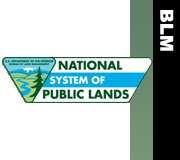|
Print Page | |||||
| Cody Field Office | ||||||
Grazing Administration The Cody Field Office authorizes livestock grazing on approximately 1.1 million acres of public lands. In total, the Field Office manages 232 allotments, which are held by 139 different individuals or corporations, some of which extend into Montana and the Worland Field Office area. Livestock grazing allotments in the Cody Field Office range in size from less than an acre to 55,000 acres. Some small parcels of public land in the field office are reserved from grazing because of accessibility and/or to protect other resource values such as wildlife, riparian, recreation and water.
Find out more about grazing administration and rangeland resources in the Cody Field Office. Rangeland Resources
Many of these lands are classified as saline upland range sites (pictured right), which support woody plants including: Gardners saltbush, bud sagebrush, birdfoot sagebrush, and greasewood. Perennial grasses on these sites may include: Indian rice grass, bottlebrush squirreltail, western wheatgrass, and sandberg bluegrass. Some of these sites were disturbed by heavy grazing in the past, which resulted in blue grama replacing key cool season bunchgrasses. Foothill areas on the west and east sides of the basin receive 10 to 14 inches of precipitation annually and include sandy or loamy range sites (pictured left). These sites support: big sagebrush, and numerous perennial bunchgrass species. Higher elevation range sites receive 15 to 19 inches of precipitation annually. In addition to the species found in the lower elevation loamy range sites, the following species can be found in the higher elevation sites: Columbia and green needlegrass, and kingspike and Idaho fescue. Juniper, pine forests and aspen groves are also common in these areas. |
||||||









